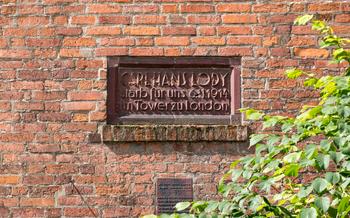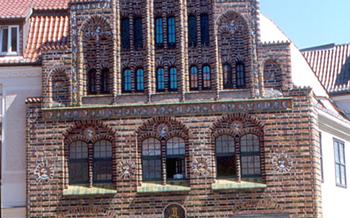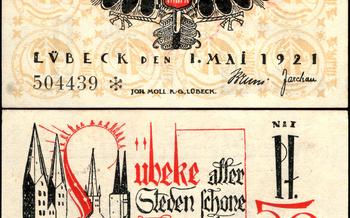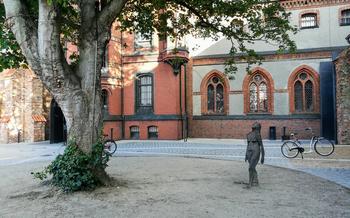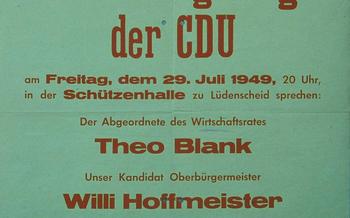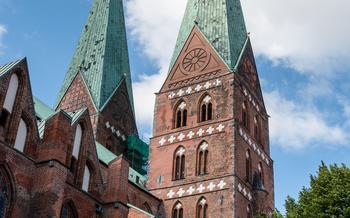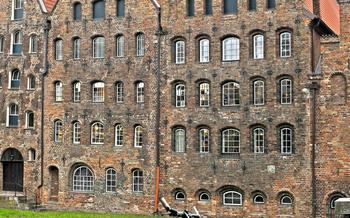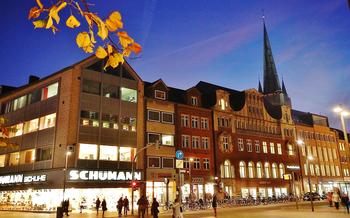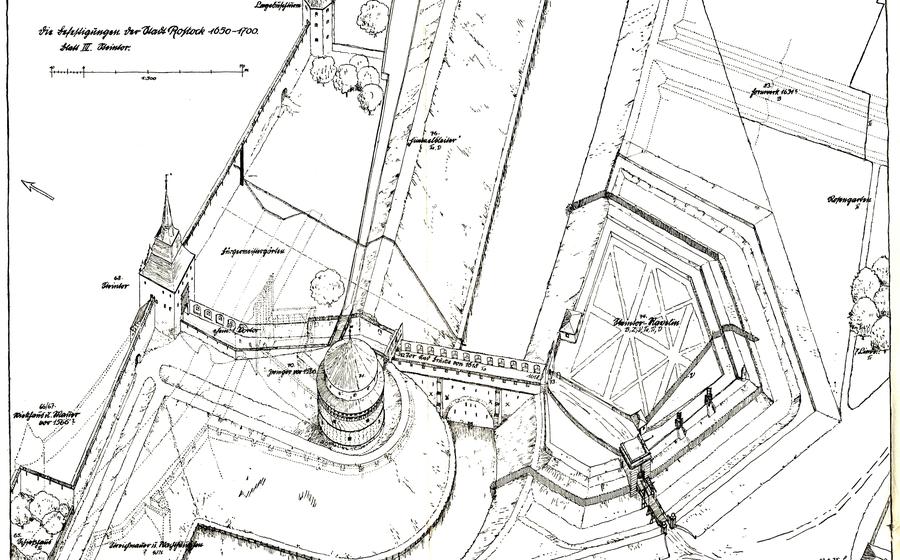
Rostock City Wall and Gates
- Explore the Rich History of Rostock's City Wall and Gates
- Architectural Features
- Walking the Wall
- Historical Landmarks
- Interactive Displays
- Guided Tours: Unveiling the Secrets of Rostock's City Wall
- Panoramic Views
- Legends and Folklore
- Local Cuisine
- Souvenirs and Shopping
- Accessibility
- Insider Tip: Uncovering the Hidden Bastion
Explore the Rich History of Rostock's City Wall and Gates
Rostock's City Wall and Gates stand as testaments to the city's rich history and resilience. Built in the 13th century, the wall served as a protective barrier against attacks, safeguarding the city's status as a vital trading hub within the Hanseatic League. Over the centuries, the wall underwent numerous modifications and expansions, reflecting the city's growth and prosperity.
In the 19th century, as Rostock's fortifications lost their military significance, the wall underwent a remarkable transformation. Large sections were demolished to make way for urban development, while others were preserved and restored. Today, the remaining portions of the wall, along with the seven monumental gates, offer a glimpse into Rostock's past and serve as a reminder of the city's enduring spirit.
Architectural Features
The Rostock City Wall and Gates are remarkable examples of medieval fortifications, showcasing a blend of architectural techniques and influences. The wall's massive stone foundations, dating back to the 13th century, provide a solid base for the imposing brick superstructure added in the 15th century. The use of bricks, a common building material in northern Germany, allowed for greater flexibility and speed in construction, enabling the city to expand its defenses quickly.
The wall's design incorporated various elements to enhance its defensive capabilities. Towers, strategically positioned along the wall's length, provided elevated vantage points for spotting approaching threats and launching counterattacks. Bastions, projecting outward from the wall, offered additional protection by allowing defenders to fire along the wall's length and into the moat below. The moat, a water-filled trench surrounding the wall, served as a formidable obstacle to attackers, hindering their progress and making scaling the walls more challenging.
The gates, the main entry points to the city, were elaborately designed and heavily fortified. Each gate featured a gate tower, a sturdy structure housing a portcullis and drawbridge, along with guard rooms and living quarters for the gatekeepers. The gates were also adorned with intricate carvings, decorative brickwork, and stepped gables, reflecting the influence of Gothic and Renaissance architectural styles. These decorative elements added a touch of grandeur to the otherwise utilitarian structures, showcasing the city's pride and prosperity.
Walking the Wall
Visitors to Rostock have the unique opportunity to walk along the remaining sections of the city wall, offering a captivating journey through history and stunning views. The wall's promenade stretches for approximately 2 kilometers, providing a leisurely stroll or a brisk walk, depending on your preference.
Starting from the city center, you can access the wall from various points. One popular starting point is the Steintor, a magnificent gate tower that once guarded the city's western entrance. From here, you can embark on a walk along the wall's southern section, passing by the imposing towers and bastions that once defended the city.
As you walk along the wall, you'll be treated to panoramic views of Rostock and its surroundings. The city's rooftops, the spires of its churches, and the vast expanse of the Baltic Sea create a breathtaking backdrop for your walk.
The walk is relatively easy, with well-maintained paths and viewing platforms. However, be sure to wear comfortable shoes as the surface can be uneven in some places. The entire walk takes approximately 1-2 hours, depending on your pace and how often you stop to admire the views or take photos.
Historical Landmarks
Along the preserved sections of Rostock's City Wall, visitors can encounter a captivating array of historical landmarks that narrate the city's rich past. Towering over the fortifications, the majestic St. Mary's Church stands as a testament to the city's spiritual heritage. Its intricate Gothic architecture and soaring spires dominate the skyline, beckoning visitors to explore its hallowed interior.
Another architectural marvel is the Town Hall, a symbol of Rostock's civic pride and authority. Built in the 13th century, it showcases a blend of Gothic and Renaissance styles, adorned with intricate carvings and decorative gables. Inside, visitors can admire the grand Council Chamber, adorned with exquisite murals depicting scenes from Rostock's history.
The Zeughaus, or Arsenal, is a reminder of Rostock's maritime prowess. Constructed in the 16th century, this imposing building once housed the city's weapons and military equipment. Today, it serves as a museum, showcasing exhibits on Rostock's military history and its role in the Hanseatic League.
These landmarks, interwoven with the ancient City Wall, offer a tangible connection to Rostock's past. As visitors stroll along the fortifications, they can immerse themselves in the city's rich history, where every stone whispers tales of resilience, prosperity, and cultural heritage.
Interactive Displays
The Rostock City Wall and Gates are not just historical landmarks, but also interactive experiences that bring history to life. Visitors can enhance their understanding of the wall's significance through various interactive displays and exhibitions. Touchscreens, models, and audio guides provide detailed information on the wall's construction, defense mechanisms, and the daily lives of the people who lived within its protective embrace.
One of the most popular interactive displays is the 3D model of the city, which allows visitors to explore the urban landscape as it existed in the Middle Ages. Visitors can zoom in on specific buildings, rotate the model, and learn about the city's layout and development over time.
Another interactive exhibit showcases the different construction techniques used in the wall's construction. Visitors can touch and feel the various materials, such as bricks, stones, and mortar, and learn about the engineering challenges faced by the builders.
Interactive displays are not just educational but also entertaining, making the Rostock City Wall and Gates a truly immersive experience. They provide a deeper understanding of the wall's history and significance, while also making the visit more engaging and enjoyable for visitors of all ages.
Guided Tours: Unveiling the Secrets of Rostock's City Wall
Exploring the Rostock City Wall and Gates with a knowledgeable guide is an enriching experience that brings the history of this iconic landmark to life. Guided tours offer a deeper understanding of the wall's construction, significance, and the stories that have unfolded within its walls.
There are various types of guided tours to choose from, catering to different interests and preferences. Walking tours provide an intimate exploration of the wall, allowing visitors to get up close and personal with its architectural features and historical landmarks. Bike tours offer a more active and comprehensive experience, covering a larger area and providing a unique perspective of the city. For those who prefer a leisurely approach, boat tours offer stunning views of the wall from the water, highlighting its grandeur and strategic location.
Whether you opt for a walking, biking, or boat tour, you'll be accompanied by experienced guides who are passionate about Rostock's history. They'll share fascinating insights, stories, and anecdotes that bring the wall's past to life. You'll learn about the Hanseatic League's influence, the defensive strategies employed during sieges, and the lives of the people who lived and worked within the city walls.
To make the most of your guided tour experience, consider booking in advance, especially during peak tourist season. Check online or inquire at the local tourist information center for tour schedules and availability. Some tours may require a minimum number of participants, so it's advisable to plan accordingly.
Whether you're a history buff, an architecture enthusiast, or simply someone who appreciates the beauty of ancient fortifications, a guided tour of the Rostock City Wall and Gates is an unforgettable experience that will leave you with a deeper appreciation for this remarkable landmark.
Panoramic Views
The Rostock City Wall and Gates offer breathtaking panoramic views of the city, the harbor, and the surrounding countryside. From the top of the wall, visitors can gaze out over the red-roofed buildings of the Old Town, the spires of the Marienkirche and St. Petri Church, and the vast expanse of the Baltic Sea. On a clear day, it is even possible to see the distant shores of Sweden.
The best time to enjoy the panoramic views from the wall is during sunset, when the sky turns a kaleidoscope of colors and the city lights begin to twinkle. It is a truly magical experience to stand atop the ancient wall and watch the sun sink below the horizon, casting a warm glow over the cityscape.
For those who are looking for a truly unforgettable experience, I recommend taking a guided tour of the wall at night. Under the cloak of darkness, the wall takes on a whole new persona, and the views from the top are even more stunning. It is a truly unique way to experience the history and beauty of Rostock.
Legends and Folklore
Rostock's City Wall and Gates are steeped in legends and folklore that have captured the imagination of locals and visitors alike for centuries. One of the most famous tales is that of the "White Lady," a ghostly figure said to haunt the walls. According to legend, she is the spirit of a young woman who was unjustly accused of witchcraft and burned at the stake. Her ghost is said to appear on stormy nights, searching for her lost love.
Another popular legend is that of the "Gatekeeper's Dog." This loyal canine is said to have defended the city gates against a fierce attack by a neighboring town. The dog fought bravely, but was eventually outnumbered and killed. His spirit is said to still roam the walls, guarding the city from harm.
These legends and stories have been passed down through generations, becoming an integral part of Rostock's cultural identity. They add an air of mystery and intrigue to the city's already rich history, making it a fascinating destination for visitors interested in exploring the supernatural.
Local Cuisine
Exploring the Rostock City Wall and Gates is not just a journey through history but also a culinary adventure. While strolling along the wall, visitors can savor the flavors of local cuisine at charming restaurants or cafes with stunning views of the city.
One must-try dish is the "Rostocker Fischbrötchen," a traditional fish sandwich made with freshly caught herring, pickled gherkins, and onions, served on a hearty roll. For a taste of local beer, try the "Rostocker Pils," a refreshing pilsner brewed according to centuries-old tradition.
Vegetarians can indulge in "Mecklenburger Kartoffelsuppe," a hearty potato soup with vegetables and herbs, a regional specialty. And for a sweet treat, don't miss the "Rostocker Marzipan," a delicious almond confection that has been a local delicacy for centuries.
Whether you're looking for a quick bite or a leisurely meal, the culinary delights of Rostock will enhance your exploration of the city's historical landmark.
Souvenirs and Shopping
Amidst your exploration of Rostock's City Wall and Gates, take a moment to browse the charming souvenir shops and markets that line the streets. These shops offer a treasure trove of mementos and keepsakes that will remind you of your journey. From traditional postcards and magnets to intricate replicas of the wall, you'll find a wide array of souvenirs to choose from.
Rostock is also home to a vibrant community of local artisans and craftspeople. Their unique creations, such as hand-painted ceramics, delicate lacework, and intricately carved wooden figures, make for memorable souvenirs. Explore the local markets or visit the workshops of these artisans to discover one-of-a-kind pieces that capture the essence of Rostock.
As you shop, keep an eye out for souvenirs made from local materials or inspired by local traditions. These items, such as amber jewelry, maritime-themed crafts, or products made from locally sourced wool, offer a deeper connection to the region's heritage.
Whether you're looking for a small token to remember your visit or a special gift for a loved one, Rostock's souvenir shops and markets have something for everyone. Embrace the spirit of exploration and discover the unique treasures that await you.
Accessibility
Navigating the Rostock City Wall and Gates is made inclusive for individuals with disabilities through thoughtful design and accessibility features. Wheelchair-accessible routes have been carefully curated, ensuring that visitors of all abilities can immerse themselves in the city's rich history and stunning architecture. Viewing platforms have been strategically placed, allowing those using wheelchairs to enjoy the same breathtaking vistas as others. Additionally, audio guides and sign language interpretation services are available, catering to the needs of the hearing-impaired. With these accessible features, the Rostock City Wall and Gates welcome everyone to embark on a journey through time, embracing the city's heritage without limitations.
Insider Tip: Uncovering the Hidden Bastion
Venture beyond the main tourist routes and discover a hidden gem nestled among the fortifications: the secluded Bastion XI. This lesser-known bastion offers a tranquil escape from the crowds, with its charming garden and panoramic views of the city. Find your way to the bastion through a secret passageway, concealed behind a weathered gate along the wall. As you emerge into the garden, you'll be greeted by a serene oasis filled with fragrant flowers, ancient trees, and the gentle sound of birdsong. Take a moment to relax on a bench and soak in the breathtaking views of Rostock's rooftops and spires, stretching out towards the distant horizon. This hidden bastion is a true insider's secret, where you can experience the tranquility and beauty of the city wall away from the hustle and bustle.
